Higher classification Coriandrum | Genus Coriandrum Rank Species | |
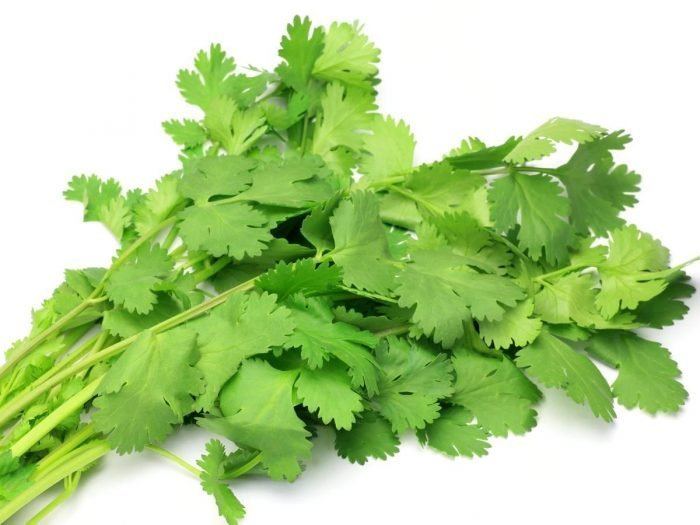 | ||
Similar Cumin, Parsley, Chili pepper, Garlic, Turmeric | ||
How to grow coriander at home
Coriander ( /ˌkɒrɪˈændə/; /ˈkɔːriˌændər/ or /ˌkɔːriˈændər/; Coriandrum sativum), also known as cilantro (/sɪˈlɑːntroʊ/) or Chinese parsley, is an annual herb in the family Apiaceae. All parts of the plant are edible, but the fresh leaves and the dried seeds are the parts most traditionally used in cooking.
Contents
- How to grow coriander at home
- Botanical description
- Etymology
- History
- Uses
- Leaves
- Fruits
- Food applications
- Research
- Roots
- Flowering coriander for aphid control
- Nutrients
- Taste and smell
- Similar plants
- Allergy
- References
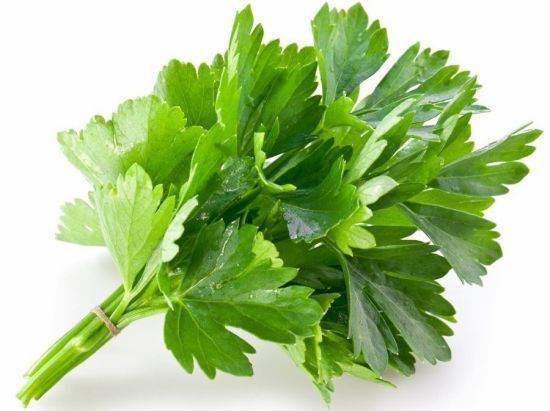
Botanical description
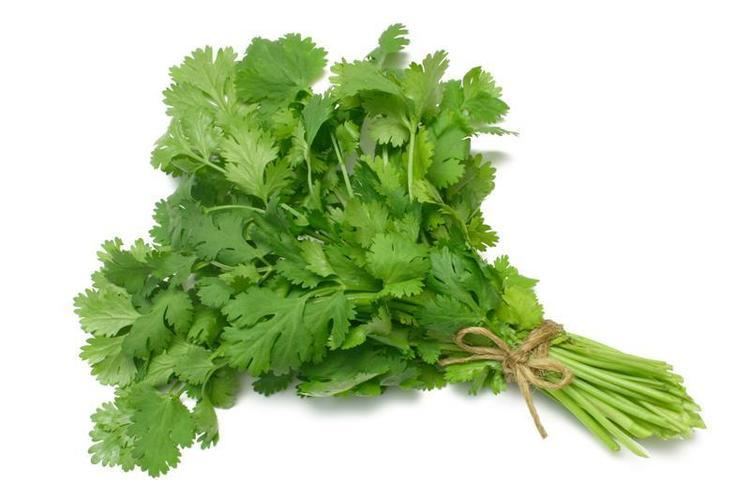
Coriander is native to regions spanning from southern Europe and northern Africa to southwestern Asia. It is a soft plant growing to 50 cm (20 in) tall. The leaves are variable in shape, broadly lobed at the base of the plant, and slender and feathery higher on the flowering stems. The flowers are borne in small umbels, white or very pale pink, asymmetrical, with the petals pointing away from the center of the umbel longer (5–6 mm or 0.20–0.24 in) than those pointing toward it (only 1–3 mm or 0.039–0.118 in long). The fruit is a globular, dry schizocarp 3–5 mm (0.12–0.20 in) in diameter.
Etymology

First attested in English in the late 14th century, the word "coriander" derives from the Old French: coriandre, which comes from Latin: coriandrum, in turn from Ancient Greek: κορίαννον koriannon. The earliest attested form of the word is the Mycenaean Greek ko-ri-ja-da-na written in Linear B syllabic script (reconstructed as koriadnon, similar to the name of Minos's daughter Ariadne) which later evolved to koriannon or koriandron.
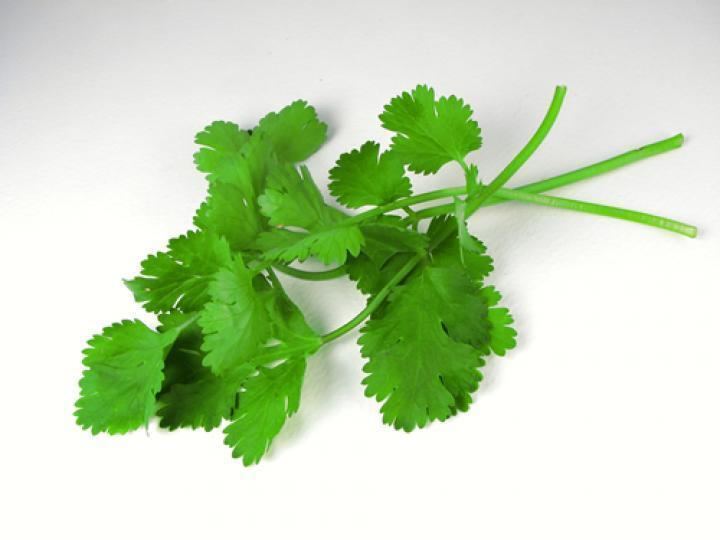
Cilantro is the Spanish word for coriander, also deriving from coriandrum. It is the common term in North American English for coriander leaves, due to their extensive use in Mexican cuisine.
History

Coriander grows wild over a wide area of Western Asia and southern Europe, prompting the comment, "It is hard to define exactly where this plant is wild and where it only recently established itself." Fifteen desiccated mericarps were found in the Pre-Pottery Neolithic B level of the Nahal Hemar Cave in Israel, which may be the oldest archaeological find of coriander. About half a litre (a pint) of coriander mericarps was recovered from the tomb of Tutankhamen, and because this plant does not grow wild in Egypt, Zohary and Hopf interpret this find as proof that coriander was cultivated by the ancient Egyptians.
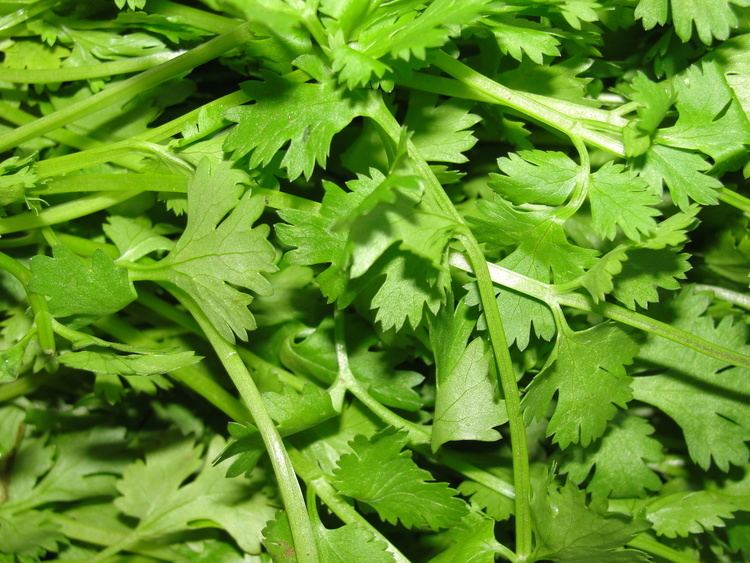
Coriander seems to have been cultivated in Greece since at least the second millennium BC. One of the Linear B tablets recovered from Pylos refers to the species as being cultivated for the manufacture of perfumes, it apparently was used in two forms: as a spice for its seeds and as a herb for the flavour of its leaves. This appears to be confirmed by archaeological evidence from the same period; the large quantities of the species retrieved from an Early Bronze Age layer at Sitagroi in Macedonia could point to cultivation of the species at that time.
Coriander was brought to the British colonies in North America in 1670, and was one of the first spices cultivated by early settlers.
Uses
All parts of the plant are edible, but the fresh leaves and the dried seeds are the parts most traditionally used in cooking. Coriander is used in cuisines throughout the world.
Leaves
The leaves are variously referred to as coriander leaves, fresh coriander, dhania, Chinese parsley, or (in the US and commercially in Canada) cilantro.
Coriander potentially may be confused with culantro (Eryngium foetidum L.), an Apiaceae like coriander (Coriandrum sativum L.), but from a different genus. Culantro has a distinctly different spiny appearance, a more potent volatile leaf oil and a stronger aroma.
The leaves have a different taste from the seeds, with citrus overtones. However, some people find the leaves to have an unpleasant soapy taste or a rank smell and avoid them.
The fresh leaves are an ingredient in many South Asian foods (such as chutneys and salads); in Chinese and Thai dishes; in Mexican cooking, particularly in salsa and guacamole and as a garnish; and in salads in Russia and other CIS countries. Chopped coriander leaves are a garnish on Indian dishes such as dal. As heat diminishes their flavour, coriander leaves are often used raw or added to the dish immediately before serving. In Indian and Central Asian recipes, coriander leaves are used in large amounts and cooked until the flavour diminishes. The leaves spoil quickly when removed from the plant, and lose their aroma when dried or frozen.
Fruits
The dry fruits are known as coriander seeds. The word "coriander" in food preparation may refer solely to these seeds (as a spice), rather than to the plant. The seeds have a lemony citrus flavour when crushed, due to terpenes linalool and pinene. It is described as warm, nutty, spicy, and orange-flavoured.
The variety C. s. vulgare has a fruit diameter of 3–5 mm (0.12–0.20 in), while var. C. s. microcarpum fruits have a diameter of 1.5–3 mm (0.06–0.12 in). Large-fruited types are grown mainly by tropical and subtropical countries, e.g. Morocco, India, and Australia, and contain a low volatile oil content (0.1-0.4%). They are used extensively for grinding and blending purposes in the spice trade. Types with smaller fruit are produced in temperate regions and usually have a volatile oil content around 0.4-1.8%, so are highly valued as a raw material for the preparation of essential oil.
Food applications
Coriander is commonly found both as whole dried seeds and in ground form. Roasting or heating the seeds in a dry pan heightens the flavour, aroma, and pungency. Ground coriander seed loses flavour quickly in storage and is best ground fresh. Coriander seed is a spice in garam masala and Indian curries which often employ the ground fruits in generous amounts together with cumin, acting as a thickener in a mixture called dhana jeera.
Roasted coriander seeds, called dhana dal, are eaten as a snack. They are the main ingredient of the two south Indian dishes: sambhar and rasam.
Outside of Asia, coriander seed is used widely in the process for pickling vegetables. In Germany and South Africa (see boerewors), the seeds are used while making sausages. In Russia and Central Europe, coriander seed is an occasional ingredient in rye bread (e.g. Borodinsky bread), as an alternative to caraway.
The Zuni people of North America have adapted it into their cuisine, mixing the powdered seeds ground with chile and using it as a condiment with meat, and eating leaves as a salad.
Coriander seeds are used in brewing certain styles of beer, particularly some Belgian wheat beers#Witbier. The coriander seeds are used with orange peel to add a citrus character.
Coriander seed is one of the main traditional ingredients in the South African Boerewors, a popular spiced mixed-meat sausage.
Research
One preliminary study showed coriander essential oil to inhibit Gram-positive and Gram-negative bacteria, including Staphylococcus aureus, Enterococcus faecalis, Pseudomonas aeruginosa, and Escherichia coli.
Roots
Having a deeper, more intense flavor than the leaves, coriander roots are used in a variety of Asian cuisines, especially in Thai dishes such as soups or curry pastes.
Flowering coriander for aphid control
In the Salinas Valley of California, aphids have been one of the worst pests in the lettuce fields. The USDA Cooperative Extension Service has been investigating organic methods for aphid control, and experimented with coriander plants and Alyssum plants; when intercropped with the lettuce and allowed to flower, they attract beneficial insects such as hoverflies, the larvae of which eat up to 150 aphids per day before they mature into flying adults.
Nutrients
The nutritional profile of coriander seeds is different from the fresh stems or leaves. Leaves are particularly rich in vitamin A, vitamin C and vitamin K, with moderate content of dietary minerals (table above). Although seeds generally have lower content of vitamins, they do provide significant amounts of dietary fiber, calcium, selenium, iron, magnesium and manganese.
Taste and smell
Different people may perceive the taste of coriander leaves differently. Those who enjoy it say it has a refreshing, lemony or lime-like flavor, while those who dislike it have a strong aversion to its taste and smell, characterizing it as soapy or rotten. Studies also show variations in preference among different ethnic groups: 21% of East Asians, 17% of Caucasians, and 14% of people of African descent expressed a dislike for coriander, but among the groups where coriander is popular in their cuisine, only 7% of South Asians, 4% of Hispanics, and 3% of Middle Eastern subjects expressed a dislike.
Twin studies have shown that 80% of identical twins shared the same preference for the herb, but fraternal twins agreed only about half the time, strongly suggesting a genetic component to the preference. In a genetic survey of nearly 30,000 people, two genetic variants linked to perception of coriander have been found, the most common of which is a gene involved in sensing smells. The gene, OR6A2, lies within a cluster of olfactory-receptor genes, and encodes a receptor that is highly sensitive to aldehyde chemicals. Flavor chemists have found that the coriander aroma is created by a half-dozen or so substances, and most of these are aldehydes. Those who dislike the taste are sensitive to the offending unsaturated aldehydes, while simultaneously may also be unable to detect the aromatic chemicals that others find pleasant. Association between its taste and several other genes, including a bitter-taste receptor, have also been found.
Similar plants
Other herbs are used where they grow in much the same way as coriander leaves.
Allergy
Coriander can produce an allergic reaction in some people.
